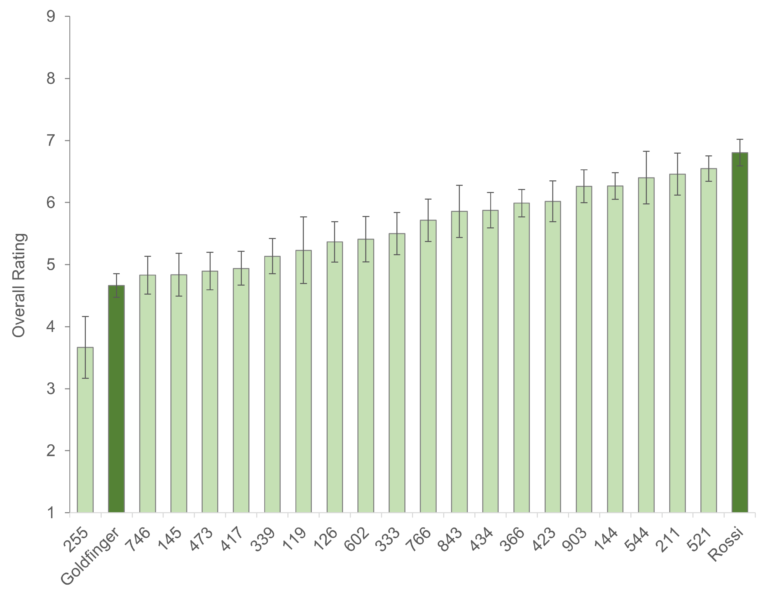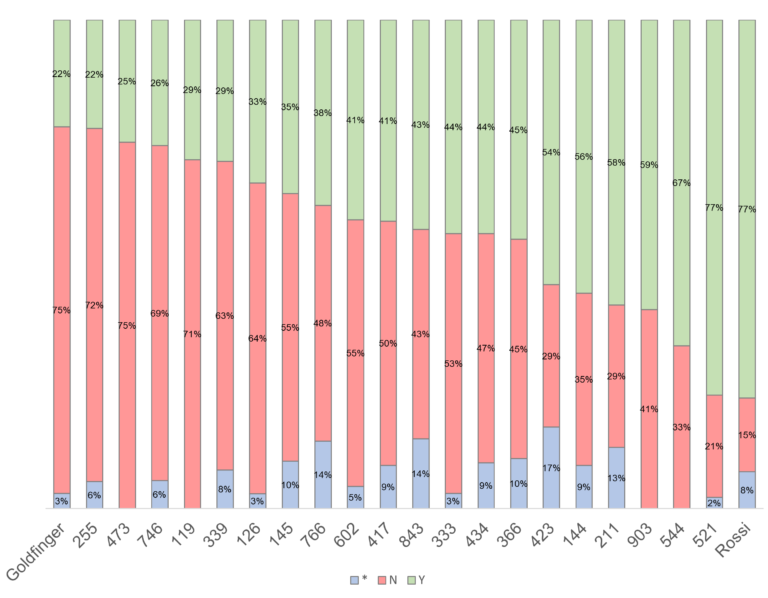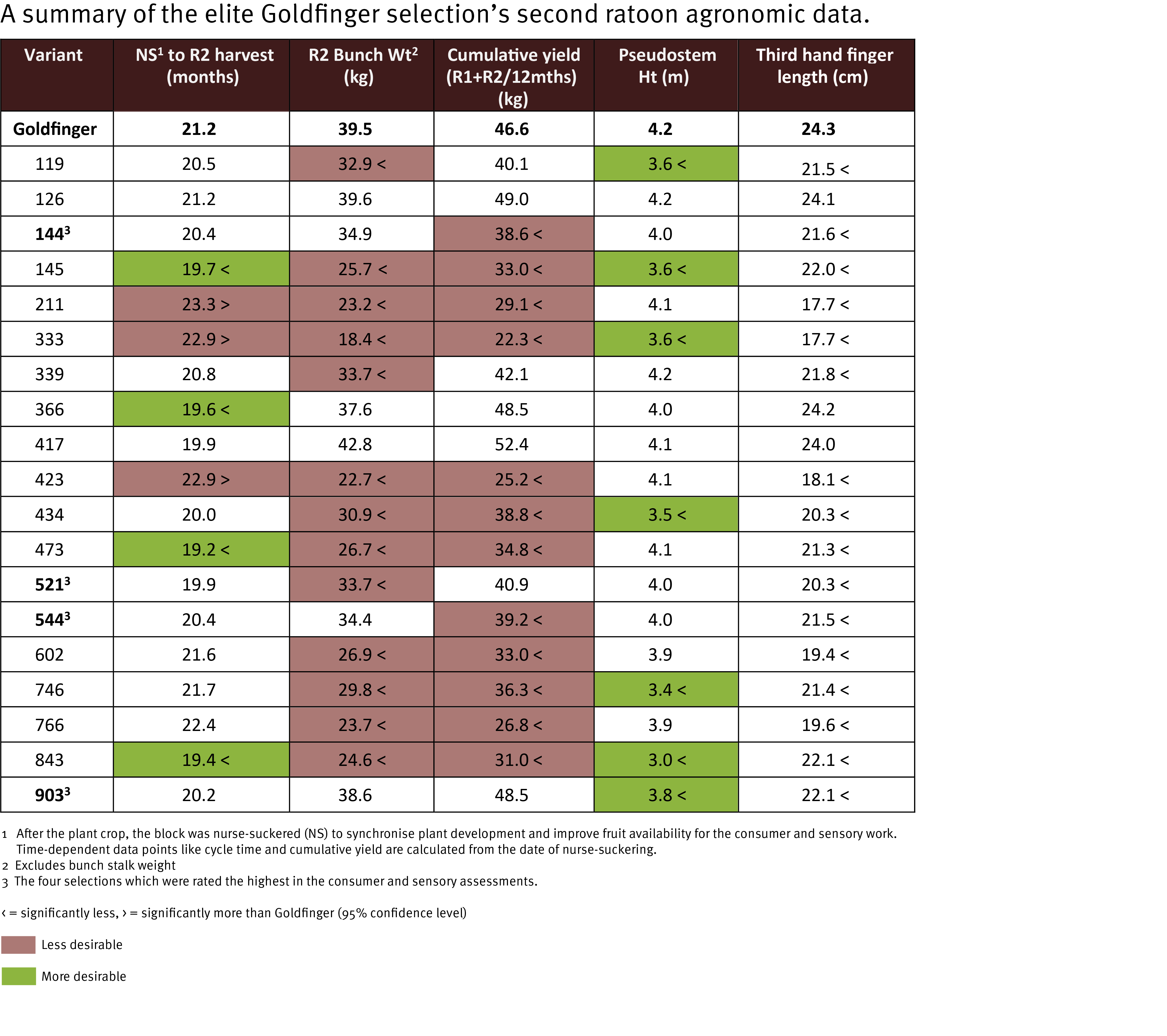Goldfinger mutagensis—screening activities
Screening of the top 20 selections
Following the selection of the top 20 variants from the original 630 plants, sucker and bit material from the original trial was planted in September and October 2019.
Bunches of the 20 variants began to emerge from the more established plants in March 2020 and continued throughout the year; the final harvest was performed in January 2021. Data was again collected on both agronomic performance and eating characteristics to substantiate the findings from the first investigation.
The taste panelling occurred once a week, with a maximum of six variants tasted in one session (including a Goldfinger and a Lady Finger ‘Dwarf Rossi’ as control samples to compare against). Panellists included colleagues who volunteered to taste the fruit under ‘controlled’ conditions at the research station and the family members and friends of those who took fruit home.
Each variant was tasted 3—4 times over the six-month trial period, except for variant 423 (which was only tasted twice due to late bunch emergence). Taste preference was ranked on a hedonic scale, which included the following categories: 1 = dislike extremely, 2 = dislike very much, 3 = dislike moderately, 4 = dislike slightly, 5 = neither like nor dislike, 6 = like slightly, 7 = like moderately, 8 = like very much, and 9 = like extremely.
Dwarf Rossi, the Lady Finger comparison, scored the highest overall rating (at 6.8) of all the varieties included in the taste panelling (Figure 1), corresponding with 77% of respondents indicating they would purchase it if it were commercially available (Figure 2). This was closely followed by variant 521, which was the best performer out of all the Goldfinger variants with an average rating of 6.5.


Several comments were made that this variant had similar eating characteristics to a Lady Finger. The Goldfinger control was rated poorly, 4.7 on average, with 255 the only variant below it at 3.7. Variants 211, 544, 144 and 903 joined 521 in making up the five selections given the highest overall eating experience rating, and which also had the greatest number of people answer ‘yes’ to the question: ‘if this fruit was commercially available, would you choose to purchase it?’
The plant heights of all the selected variants were not significantly different from the 3.1 m Goldfinger average. The total fruit yield was also comparable to the average Goldfinger bunch (27.3 kg) for three of the selected variants, while the other two were 15—20% lower.
There were a couple of variants with undesirable characteristics which had gone undetected in the original selection of top performers. For example, several plants from one variant had severely fused fingers – to the point where several hands in a bunch were unusable.
Another variant had fruit which retained a green-tinge upon ripening. The relatively tall (3.5 m) and thin pseudostem (54 cm) of another contributed to two of the ten plants snapping before bunch maturity; its brittle pseudostem also made harvesting difficult. Such issues prevented these three variants from being pursued further.
March 2023 saw the final bunches of the second ratoon crop harvested from these twenty selections at South Johnstone. The agronomic results from nineteen of these selections are summarised in the accompanying table. Variant 255 was excluded after the first ratoon due to its excessive height and slender pseudostem, which made harvesting very difficult. Its fruit was also rated poorly in the South Johnstone consumer surveys.
The trial block has been nurse suckered and prepared for rating the susceptibility of the variants to yellow Sigatoka in the coming months.
Key observations from second ratoon:
Seven out of the nineteen selections had plant heights shorter than standard Goldfinger, which stood at 4.2 m. In most cases the pseudostem circumference was also smaller, meaning these plants remained proportionally comparable to Goldfinger.
Most variants had shorter finger lengths than the original Goldfinger by an average of 3 – 4 cm. The consumer study found this was generally regarded as preferable, as Goldfinger was rated as ‘too big’ by 46% of panellists.
Although variant 521 averaged a smaller bunch size (15% less than Goldfinger), its slightly faster cycle time meant the cumulative yield was not significantly different to Goldfinger. This was also the case for selections 119 and 339 (which were also aided by having slightly heavier bunches in the first ratoon).
In contrast, variants 544 and 144, which had similar second ratoon bunch weights to Goldfinger, had lower cumulative yields by 16 and 17%, respectively, due to lower bunch weights in the first ratoon.

Yellow Sigatoka screening results
Click here for more information on the yellow Sigatoka screening trials completed for the top 20 mutant selections. This trial assessed the selections’ resistance or susceptibility to the fungal leaf disease, yellow Sigatoka during the 2023 wet season.
This Goldfinger work was initiated as part of the Fusarium Wilt Tropical Race 4 Research Program (BA14014). At the close of BA14014 funding has been provided through the project Improved Plant Protection for the Banana Industry (BA16001) for continuation of the evaluations. This project has been funded by Hort Innovation, co-investment from the Queensland Department of Agriculture and Fisheries, and contributions from the Australian Government. Hort Innovation is the grower-owned, not-for-profit research and development corporation for Australian horticulture.


